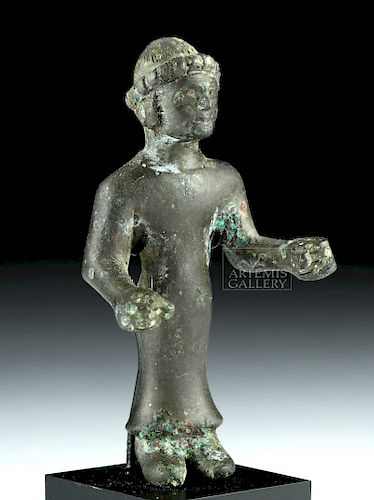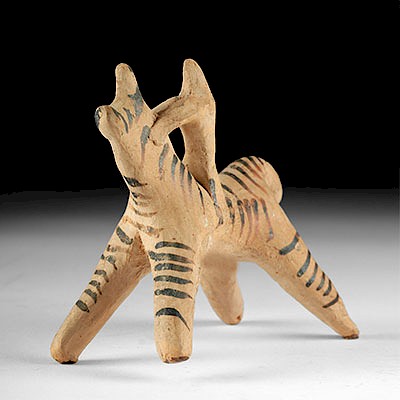Etruscan Bronze Figure of Charioteer
Lot 45
About Seller
Artemis Fine Arts
686 S Taylor Ave, Ste 106
Louisville, CO 80027
United States
Selling antiquities, ancient and ethnographic art online since 1993, Artemis Gallery specializes in Classical Antiquities (Egyptian, Greek, Roman, Near Eastern), Asian, Pre-Columbian, African / Tribal / Oceanographic art. Our extensive inventory includes pottery, stone, metal, wood, glass and textil...Read more
Estimate:
$1,000 - $1,500
Absentee vs Live bid
Two ways to bid:
- Leave a max absentee bid and the platform will bid on your behalf up to your maximum bid during the live auction.
- Bid live during the auction and your bids will be submitted real-time to the auctioneer.
Bid Increments
| Price | Bid Increment |
|---|---|
| $0 | $25 |
| $300 | $50 |
| $1,000 | $100 |
| $2,000 | $250 |
| $5,000 | $500 |
| $10,000 | $1,000 |
| $20,000 | $2,500 |
| $50,000 | $5,000 |
| $100,000 | $10,000 |
| $200,000 | $20,000 |
About Auction
By Artemis Fine Arts
Oct 25, 2018
Set Reminder
2018-10-25 11:00:00
2018-10-25 11:00:00
America/New_York
Bidsquare
Bidsquare : Antiquities from Egypt, Greece, Italy, Asia
https://www.bidsquare.com/auctions/artemis-gallery/antiquities-from-egypt-greece-italy-asia-3538
Featuring Egyptian, Greek, Roman, Etruscan, Near Eastern, plus Asian art from Central and Far East. If you love the classics, this is the sale for you. Artemis Fine Arts info@artemisfinearts.com
Featuring Egyptian, Greek, Roman, Etruscan, Near Eastern, plus Asian art from Central and Far East. If you love the classics, this is the sale for you. Artemis Fine Arts info@artemisfinearts.com
- Lot Description
Classical World, Etruria, ca. 6th to 4th century BCE. A cast bronze male figure, standing with his arms outstretched, his hands shown in a grip, perhaps indicating that he was a charioteer holding onto reins. He wears a long garment that covers his body - all the way to his feet - and a cap-like helmet. His visage is comprised of lunate eyes, arched brows, an aquiline nose, and pursed lips. A wonderful piece referencing Etruscan chariot racing as depicted on fresco wall paintings in the Tomb of Tarquinia, Italy as well as the Tomb of Bigas. Since the Romans destroyed the Etruscan civilization, artifacts like this example along with tomb paintings serve as an invaluable glimpse into the lost world of the Etruscans. Size: 2.375" H (6 cm); 2.875" H (7.3 cm) on included custom stand.
Etruscan chariot racing was exceedingly dangerous, as the courses had bumpy hills, very steep slopes, and treacherous curves. Because of this, Etruscan charioteers were sometimes strapped to their chariots with leather belts. What's more, fatalities were expected and abundant, and this activity was banned from the Greek Olympics.
Etruria - modern day Tuscany, Lazio, and Umbria - was rich in metals, including copper, and the Etruscans drew upon their native resources to become master bronze smiths. Votive figures like this one were traded far and wide according to Pliny the Elder. Titus Livius records that when the consul Marcus Fluvius Flaccus conquered the Etruscan city of Volsinii, they took a line of wagons, including two thousand bronze statues, to Rome, where they were melted down to make coinage to finance the war against Carthage.
Provenance: private East Coast, USA collection
All items legal to buy/sell under U.S. Statute covering cultural patrimony Code 2600, CHAPTER 14, and are guaranteed to be as described or your money back.
A Certificate of Authenticity will accompany all winning bids.
We ship worldwide and handle all shipping in-house for your convenience.
#135321Intact with rich brown and green patina. Gripping hands probably once held objects - perhaps reins.Condition
- Shipping Info
-
All shipping is handled in-house for your convenience. Your invoice from Artemis Gallery will include shipping calculation instructions. If in doubt, please inquire BEFORE bidding for estimated shipping costs for individual items.
-
- Buyer's Premium



 EUR
EUR CAD
CAD AUD
AUD GBP
GBP MXN
MXN HKD
HKD CNY
CNY MYR
MYR SEK
SEK SGD
SGD CHF
CHF THB
THB














